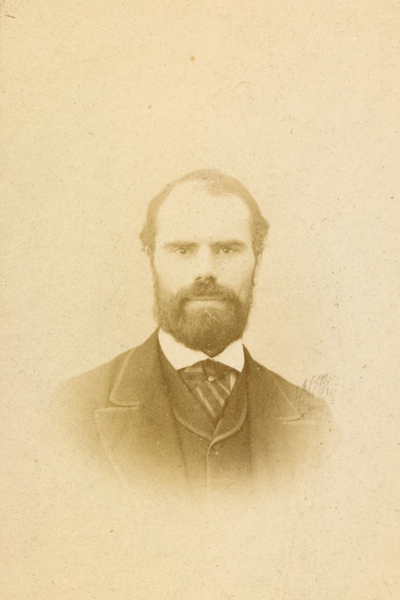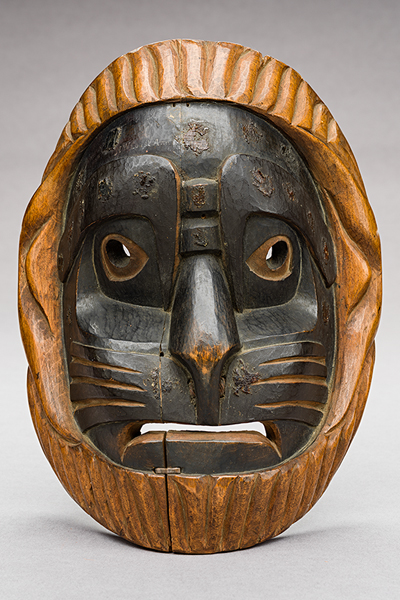Richard Gullet Whitfield and
Augustus Wollaston Franks
When Alexandra Palace opened in North London in 1875, its grounds offered the public an abundance of attractions: parklands, cricket grounds, a race course, a Great Hall seating 12,000, conservatories and gardens, a monkey house, a picture gallery, a reading room with newspapers and magazines from throughout England, and full-size reproductions of modern homes from Morocco and Egypt. One of its more educational offerings was “The Whitfield Collection, or Museum of Natural History,” described in The Official Guide to the Alexandra Palace and Park as “rich in its corals and stuffed specimens of apes and birds and other wild animals.”1 The collection included Indigenous-made objects among its 1463 curiosities, typical of late nineteenth-century conceptions of Indigenous cultures as part of the natural, as opposed to civilized, world.2
Richard Gullet Whitfield (1801-1877) developed the collection as a hobby. A third-generation administrator for St. Thomas’s Hospital and Medical School in London, he dutifully served the hospital for over fifty years, until just weeks before his death in 1877. As Hospital Apothecary and Secretary to the Medical School, he advocated for improvements in sanitation and ventilation, patient care and diet, outpatient care, and nursing. In collaboration with Florence Nightingale, he was instrumental in the founding of the Nightingale Nursing School. As described in his obituary in the St. Thomas’s Hospital Report:
He was also, from his school days, when he shot and stuffed his first bird, an ardent and omnivorous collector, and objects accumulated year by year until every room and passage in his house was a museum, and numbers of valuable specimens had to be stowed away in cupboards and lumber-rooms.3
Whitfield did not assemble his collection through travel; there is no record of him going further than Europe.4 Rather, he acquired objects through the social connections he made in his hospital work, “some of them given to him by grateful patients, many by old students who had visited or were settled in foreign countries and knew his tastes.”5 By training doctors who were dispatched throughout and beyond Britain’s empire, Whitfield created a network of collectors around the world. He likely also purchased items through dealers and local auctions. The quality of his collections was such that, in 1872, the British Museum accepted sixty-six of Whitfield’s objects from Oceania, Africa, and the Americas.
Following Whitfield’s death, Stevens Auction house organized the sale of his natural history collection at Alexandra Palace in August 1877.6 Later that fall, Augustus Franks (1826-1897) presented to the British Museum an additional five objects from Whitfield’s collection, including one that is now identified as an early Kwakwaka’wakw lion-type mask. As the museum’s Keeper of British and Mediaeval Antiquities and Ethnography, Franks expanded the ethnographic collection from 3,700 to over 38,000 artifacts during his tenure from 1851 to 1896.7 While most of these objects were acquired directly through Franks’s own network of colonial agents, he also bought extensively from exhibitions and auctions, such as the one handling the Whitfield collection.
The earliest museum record of this acquisition, dated December 15, 1877, describes it as “Whitfield Coll. Mask + four other objects.”8 Although it is likely that Franks purchased the group at the auction of the Whitfield collection, there is no confirming documentation. In the 448 lots described in the Stevens Auction catalog of the Whitfield Collection, only two masks are listed. Of those two, the “carved wooden mask, Fiji” most closely matches the formal description of the lion-type mask.9 Having seen similar examples in other collections, Franz Boas was likely the first to recognize the mask as Kwakwaka’wakw; he then published the earliest known illustration of it in his 1897 book (plate 34), identifying it there as a “Mask of the NuLmaL.” Boas’s publication seems to be the source for later updates to the British Museum’s documentation.10 At some point, both the mask itself and its catalog card had “NuLmaL” added to them, and the Kwakwaka’wakw attribution was first published in the museum’s 1910 Handbook to the Ethnographical Collections.11
By Amanda Thompson and Aaron Glass
Objects Collected by Whitfield and Franks
- Alexandra Park Trustees., The Official Guide to the Alexandra Palace and Park …, 7.
- Stevens Auction, The Whitfield Collection of Curiosities of Nature and Art.
- St. Thomas’s Hospital, “Richard Gullet Whitfield,” 378.
- Whitfield, “The Sewage Of Great Towns.”
- St. Thomas’s Hospital, “Richard Gullet Whitfield,” 378.
- Whitfield also collected rare books, prints and drawings of historic London, and fine art, as evidenced by the catalog of a second estate auction. See Catalogue of the Books, Prints, and Works of Art of the Late Richard G. Whitfield, Esq.
- For more information on Franks, see Caygill and Cherry, A. W. Franks.
- British Museum, “Christy Collection Acquisitions & Numbers.”
- Stevens Auction, The Whitfield Collection of Curiosities of Nature and Art, 8.
- We are indebted to Amber Lincoln, James Hamill, and John Davy at the British Museum, as well as Jonathan King, Marjorie Caygill, Paul Basu, and Mansi Sathyanarayan Rao for their contributions to this research.
- British Museum et al., Handbook to the Ethnographical Collections, 262.



